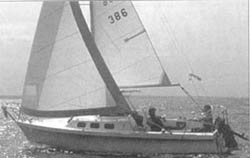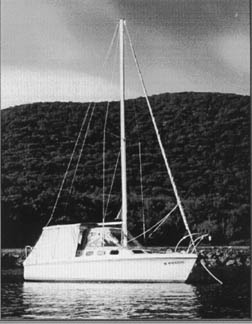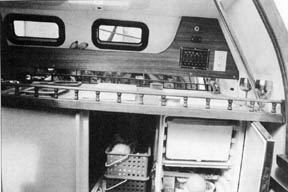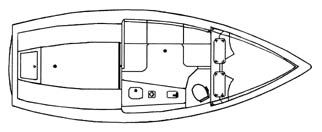by Thome Burns
 There are interesting characters in the boat building business. The
Spitzer brothers, Stan (photo left) and Eldon, are two of them to be sure. They are
engaged in building, refining and marketing the Rhodes 22. Nothing seems to excite Stan
more than to show off the score or so of gadgets they have perfected over the years to
enhance the ease of use and the functionality of the boat. They have had plenty of time to
perfect the Rhodes 22. Philip Rhodes designed the boat in 1960.
There are interesting characters in the boat building business. The
Spitzer brothers, Stan (photo left) and Eldon, are two of them to be sure. They are
engaged in building, refining and marketing the Rhodes 22. Nothing seems to excite Stan
more than to show off the score or so of gadgets they have perfected over the years to
enhance the ease of use and the functionality of the boat. They have had plenty of time to
perfect the Rhodes 22. Philip Rhodes designed the boat in 1960.
The boat is a trailerable cruiser for a couple that wants the amenities
of a larger boat without the cost or maintenance hassles of a larger boat. It makes no
claim to fame that it "sleeps five or six." Its pretty much a couple boat with
room for an occasional second couple or children. Don't get me wrong its not small down
below. The space is just not devoted to maximum sleeping quarters. When a boat is designed
with a purpose and then improved over the years it can be surprising how well the boat
actually performs its cruising purpose in a trailerable package.
I sailed the Rhodes 22 with Eldon and a customer from Mexico at the
Miami Boat Show. A front was moving in and the wind was moderate at first, between 8-12
knots but gusts were soon up in the 20 kt range. Waves were 1'-3'. Before leaving the
dock, Stan showed me his outboard system. It rests on a track slide and moves up and down
with a six to one purchase tackle system. It is the easiest outboard to raise or lower
I've seen. This boat has alot of cockpit which makes operating outboards, etc. easy. Once
away from the dock the main unfurls from the 26' mast and the 170% genoa is also furling.
The boat sails on its feet in 8 knots. It initially heels quickly in 12 knots plus gusts
but it stiffens up considerably at about 20 degrees of heel. A little rail weight helps
alot.
The boat feels responsive and is both easy to sail and fun. To put this
into perspective, the PHRF of the Catalina 22 is 270, the O'Day 22 is 279 and the Rhodes
is 258. Not a race boat like the J-22 (177), but very respectable for a 22' trailerable
cruising boat.
Design
 The Rhodes has a fairly long waterline at 20'. It has
minimal overhangs which is essential to interior volume. The hull has a pronounced flare
at the gunwales. It looks a little odd but it provides a comfortable hiking seat and
deflects spray while adding some buoyancy when heeled.
The Rhodes has a fairly long waterline at 20'. It has
minimal overhangs which is essential to interior volume. The hull has a pronounced flare
at the gunwales. It looks a little odd but it provides a comfortable hiking seat and
deflects spray while adding some buoyancy when heeled.
Unlike most trailerable sailboats built today, the Rhodes 22 uses a
shoal keel with a centerboard built in. Most boats use either water ballast or a swing
keel. With the board up, the boat draws 20" of water; 48" with the board down.
The keel/centerboard combination costs a little in initial stiffness
compared to a swing keel but for the same weight it is stiffer than water ballast because
the weight is lower. It also eliminates the winch and anoying hum of swing keel boats.
The mast is hinged and has a very effective raising and lowering
system. The 26 foot mast stores the furling mainsail. The mast is supported by nine stays
and shrouds: forestay, two backstays, two upper shrouds, two forward lowers and two aft
lowers. There is plenty of rigging to grab when walking around the deck. One disadvantage
of all this standing rigging is the extra time and effort required in preparation for
trailering and launching.
Construction
The Rhodes 22 is built in sophisticated but conventional ways with
attention to detail. The hull is laid up with a layer of chop on the skin, followed by a
layer of roving, followed by Coremat. The nearly one inch thick deck and cabin top use a
glass syntactic foam core.
For safety, the Rhodes 22 has two molded foam sections glassed into the
hull; one forward under the v-berth and one under the cockpit sole. The Spitzers said that
these make the boat unsinkable, a feature not found in most small cruisers.
The keel is molded into the hull. As an integral part of the hull,
problems associated with attachment are avoided while reinforcing the bottom of the boat.
Inside, there's a separately molded centerboard trunk, and 630 lbs. of encapsulated
ballast. The centerboard weighs 70 lbs. but requires only a braided pennant to raise it
and secure it on a cleat.
The hardware is good with Lewmar winches, Schaefer blocks and stainless
cleats. You may want to size up the winches.
Cockpit
The Rhodes 22 has a large, wide cockpit. It's 7'4" long and almost
8' wide. It's also self-bailing with bench seats on both sides and across the aft end of
the cockpit. The benches are unusual in that they are open in front which allows you to
put your feet under them. Since the Rhodes 22 has no quarter berths, it has alot of
storage area aft.
 The cockpit can also be converted into a boom room
(photo left) with the addition of a boom tent. This is quite an accessory in that it adds
a third or more to the enclosed boat.
The cockpit can also be converted into a boom room
(photo left) with the addition of a boom tent. This is quite an accessory in that it adds
a third or more to the enclosed boat.
As in modern boats, all controls lead aft and are easily at hand for
single or double-handed sailing. The most noticeable control which is not there is a boom
vang. It cannot be added due to the hinged mast and pop-top arrangement. The most unusual
arrangement is the traveler which is on a stainless tube between the backstays. It worked
well when we used it and it has the advantage of keeping the center of the cockpit open
and the cabin top open for the pop-top.
Down Below
 This is where the Spitzers have thought of most
everything. The pop-top provides 6'4" headroom. There is about 4' of sitting
headroom. The boat can be sailed with the pop-top up.
This is where the Spitzers have thought of most
everything. The pop-top provides 6'4" headroom. There is about 4' of sitting
headroom. The boat can be sailed with the pop-top up.
The cabin layout of the Rhodes 22 is roomy, open, airy and liveable.
This is a cruiser and it hasn't been compromised. It is also specifically designed for a
cruising couple. The dinette area converts into a 6' 6" double with 6' V-berths.
There are no quarter berths, but you can add room with the optional "Boom Room".
The galley and head are unusual for their completeness and size in a
boat this size. The galley has a real 4' 6" counter with sink, a stove and a large
front-opening icebox with adjustable shelves and an ice-water tap. There's a large open
storage shelf just below the ports, a deep storage cabinet underneath and more storage
berneath the counter. Built into the shelf are both 12 DC volt and 110 volt AC outlets.
The Swell Head as described by Spitzer is fully enclosed, with a clever
multi-paneled door that opens up to provide a large, non-claustrophobic space or closes to
occupy a minimum of floor space when it's not in use. There's a marine toilet, with sea
cock-controlled water intake, holding tank and fittings for dockside pump-out or macerated
discharge.
Inside, there is a mirror, shelf, toilet paper holder, medicine
cabinet, towel rack, magazine rack, lighting and a 110 volt outlet. The hatch is large and
allows you to let your upper body emerge while you stand and use the facilities.
Conclusions
The Rhodes 22 does exactly what its designed to do. It packs more
cruising capability into a small trailerable boat than most. As a cruiser for two people
or a couple with children, it is hard to beat in a trailerable boat. While it is an old
design built in a conventional way, this is not necessarily bad. Many in fact would argue
that its good. The Spitzers have had a long time to perfect the boat. I would say in many
respects its overbuilt in that over twenty-five molds are used. This means you get smoothe
under surfaces inside lazarette covers and built in shelves. The boat is virtually
"tricked-out" with handy gagdets. For the right buyers, the Rhodes 22 is
unequaled in many ways.
The Spitzers have also not forgotton their used boat customers. They
have a buy-back policy. I like and admire a company which does this. Reconditioned used
boats are sometimes available from the factory.
Thom Burns publishes Northern Breezes and Sailing Breezes.
For more information: General Boats, 114 Midway Drive, Edenton, NC 27932; 919-482-4372.
 There are interesting characters in the boat building business. The
Spitzer brothers, Stan (photo left) and Eldon, are two of them to be sure. They are
engaged in building, refining and marketing the Rhodes 22. Nothing seems to excite Stan
more than to show off the score or so of gadgets they have perfected over the years to
enhance the ease of use and the functionality of the boat. They have had plenty of time to
perfect the Rhodes 22. Philip Rhodes designed the boat in 1960.
There are interesting characters in the boat building business. The
Spitzer brothers, Stan (photo left) and Eldon, are two of them to be sure. They are
engaged in building, refining and marketing the Rhodes 22. Nothing seems to excite Stan
more than to show off the score or so of gadgets they have perfected over the years to
enhance the ease of use and the functionality of the boat. They have had plenty of time to
perfect the Rhodes 22. Philip Rhodes designed the boat in 1960. The Rhodes has a fairly long waterline at 20'. It has
minimal overhangs which is essential to interior volume. The hull has a pronounced flare
at the gunwales. It looks a little odd but it provides a comfortable hiking seat and
deflects spray while adding some buoyancy when heeled.
The Rhodes has a fairly long waterline at 20'. It has
minimal overhangs which is essential to interior volume. The hull has a pronounced flare
at the gunwales. It looks a little odd but it provides a comfortable hiking seat and
deflects spray while adding some buoyancy when heeled. The cockpit can also be converted into a boom room
(photo left) with the addition of a boom tent. This is quite an accessory in that it adds
a third or more to the enclosed boat.
The cockpit can also be converted into a boom room
(photo left) with the addition of a boom tent. This is quite an accessory in that it adds
a third or more to the enclosed boat. This is where the Spitzers have thought of most
everything. The pop-top provides 6'4" headroom. There is about 4' of sitting
headroom. The boat can be sailed with the pop-top up.
This is where the Spitzers have thought of most
everything. The pop-top provides 6'4" headroom. There is about 4' of sitting
headroom. The boat can be sailed with the pop-top up.